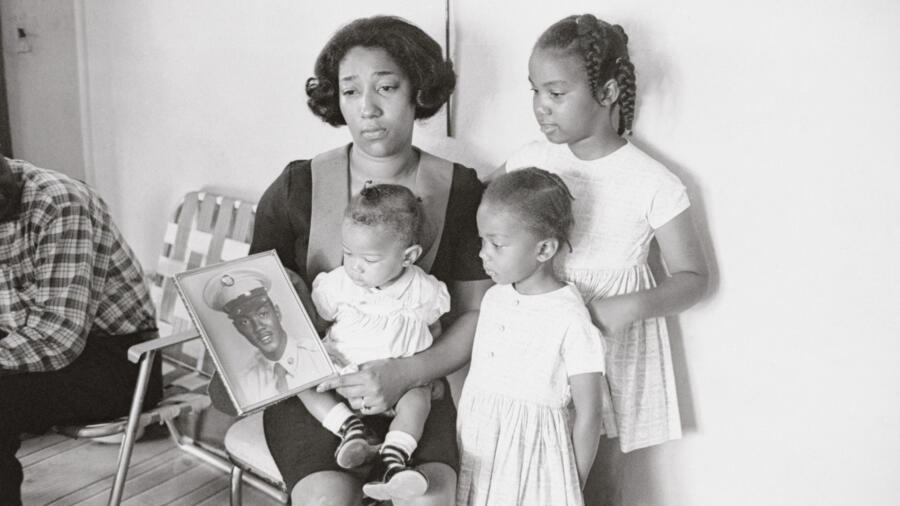June 2, 1965 — Washington Parish, Louisiana. The summer air was still. The patrol car’s engine hummed low on a dark, quiet road, no one expecting murder. Inside sat Deputy Oneal Moore, one of Louisiana’s first Black sheriff’s deputies. Beside him was his partner, Creed Rogers, also Black.
They had just completed one year and one day on the force.
It should have been a milestone.
Instead, it was a death sentence.
From behind, a truck sped up. Headlights flared. Then—gunfire. The windshield exploded. Glass, blood, and smoke filled the cabin.
Moore was killed instantly.
Rogers survived but lost vision in one eye.
Their killers were never brought to justice.
And today, Oneal Moore’s name still echoes in silence—etched into America’s long, unfinished fight for racial equality.
A Badge That Challenged White Supremacy
To understand why Moore was murdered, you must understand where he stood—and what that badge meant.
In 1960s Louisiana, the Ku Klux Klan ruled from the shadows. Their meetings were secret, their presence constant, and their threats loud but unspoken.
When Sheriff Dorman Crowe appointed Moore and Rogers in 1964, it was revolutionary. The two Black deputies became symbols of change, enforcement officers in a system that had historically hunted men like them.
But to the Klan, Moore wasn’t a deputy. He was a threat.
A Black man with authority. A Black man arresting white men.
“Unforgivable,” they said.
“Make an example of him,” they promised.
And they did.
The KKK’s Reign Over a Town in Fear
In Washington Parish, the Klan didn’t just operate—they infiltrated. They wore white robes in the woods and police badges by day.
One of the prime suspects, Elmo Breland, was later convicted of a different murder. But in Moore’s case, he remained free. The evidence was always “insufficient.” The witnesses were always “afraid.”
Even Bogalusa Police Chief Claxton Knight, the man assigned to help the FBI, was caught leaking information to Klan lawyers. The very system that should have protected Moore protected his murderers instead.
People in the community knew who did it. But they also knew the cost of speaking out:
- Retaliation
- Violence
- More bloodshed
So they said nothing. And silence became Moore’s second killer.
The FBI’s 50-Year Investigation—and a System That Still Failed
In the days following Moore’s assassination, the FBI launched an aggressive investigation.
Over the next five decades, agents:
- Collected nearly 40,000 pages of documentation
- Installed wiretaps
- Deployed undercover informants
- Captured two men confessing to the murder on tape
But it wasn’t enough.
The Department of Justice refused to prosecute, citing the lack of physical evidence—no murder weapon, no clear eyewitness, no direct tie to the crime scene.
Even with confessions.
Even with years of Klan-related violence documented across the region.
In 2016, the case was officially closed.
51 years.
Zero arrests.
Zero justice.
A Widow’s Grief. A Partner’s Burden. A Town’s Shame.
Moore’s widow raised their children alone. She never remarried. She never stopped speaking his name. And she never stopped wondering how the men who killed him were still free.
Creed Rogers, his partner, survived the ambush—but the trauma was permanent. He continued in law enforcement, blind in one eye, carrying survivor’s guilt. He died in 2007, never seeing accountability.
The community lived with the wound—and the warning.
Moore’s murder told every Black resident what could happen if they dared to stand up, speak out, or serve.
Injustice wasn’t just tolerated.
It was policy.
Oneal Moore Was More Than a Victim—He Was a Warrior
This is not just a cold case.
This is a mirror.
A reminder that in America, justice and racism have often walked side by side.
Moore’s story joins the chorus of unpunished civil rights murders:
- Medgar Evers
- James Chaney, Andrew Goodman, Michael Schwerner
- Viola Liuzzo
- Jimmie Lee Jackson
Their stories all share the same brutal truth: when the system is complicit, it cannot also be trusted to convict.
🧠 Frequently Asked Questions
Who was Oneal Moore?
He was the first Black deputy sheriff in Washington Parish, Louisiana, appointed in 1964. He was assassinated in 1965 in a KKK-led ambush.
Why was he targeted?
Because his presence in law enforcement challenged the power of white supremacy. His murder was meant to intimidate and maintain racial control.
Was anyone prosecuted?
No. Despite confessions and thousands of FBI records, no one was ever arrested or charged.
What happened to his partner?
Creed Rogers survived but was permanently blinded in one eye. He died in 2007 without ever seeing justice.
Is the case still open?
No. The Department of Justice officially closed the case in 2016, citing lack of prosecutable evidence.

